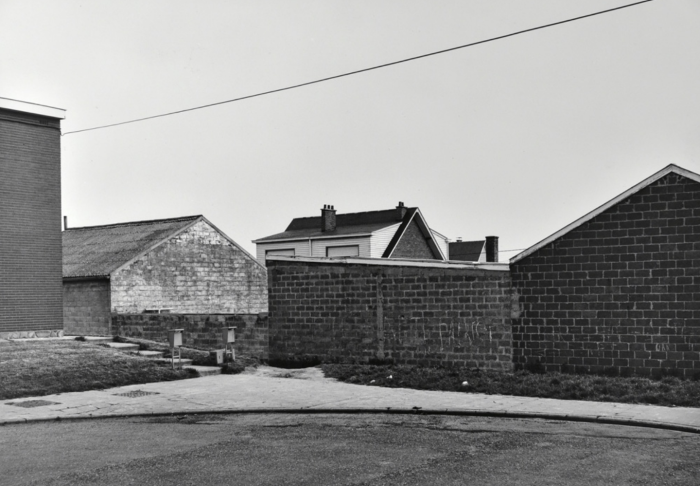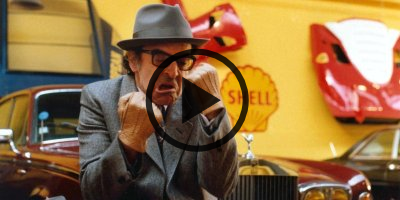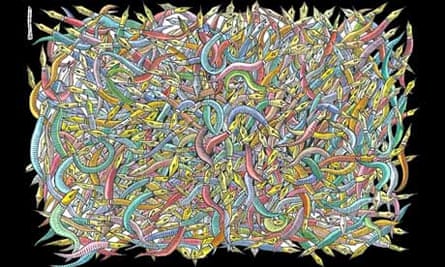
If the first paragraph of this article were the start of an Adam Curtis film, it would begin with a flat, declarative statement. Something like: “This is a film about a curious afternoon in the summer of 2016, when an American novelist pretending to be a journalist went to meet a British journalist who wanted nothing to do with being called an artist.”
The British journalist’s name is Adam Curtis. Now 61, Curtis has written or directed more than a dozen hypnotically watchable, hilarious and ominous films, all of which explore nothing less than the cultural and political subconscious of the last half of the 20th-century and the first decades of the 21st. I’d been obsessed with Curtis’s work for years; to meet him felt like a privilege. I was in a mighty fine mood too, having finished both a novel and a semester of teaching just days before. I was informed, by the friends who offered me a room in their Camden Town flat, that the London weather was good. Not good, great. Never mind that the world was in tatters and Donald Trump was smirking unstoppably toward Republican coronation. When Curtis suggested I meet him in the famous lobby of the BBC, I borrowed my host’s London map and tackled the crazy-quilt streets. My two-mile walk was exultant. A person who for years had been only an odd, welcome intruder in my brain was about to take me to lunch.
Outwardly, Curtis’s films are journalistic exposés in a documentary mode. They often extend to three or four or even five one-hour episodes; more recently they’ve consisted of single continuous presentations lasting more than two hours. Curtis is not an underground presence, not in England. He is a longtime employee of the BBC, a.k.a. (sentimentally) “the Beeb,” a pillar of 20th- and 21st-century British self-understanding. The films take familiar subjects — the Cold War, the growth of public relations or financial or military-industrial bureaucracies, the premises of the ecology or anti-psychiatry movements, the enmeshment of Western democracies in quasi-colonial military adventures in the Middle East — and render them strange. Stories that might seem like “social studies” fodder become, in Curtis’s hands, compulsive, like a giddy horror film you can’t quit watching.
His method is one of serenely bizarre juxtaposition. He pursues the art of the wild leap, at the level of both “form” (the editing in his films, which consists of abrupt jumps between disparate sequences and images) and “content” (his factual assertions, the lines he traces among seemingly unrelated events and historical actors; the music, which veers between trance-inducing techno-beats or ambient indie pop of the Brian Eno persuasion and satirically iconic standards or show tunes; and his own narration, which drones on authoritatively except when suddenly giving way to aphoristic headlines that flash on-screen in the manner of a Barbara Kruger-style gallery installation, or vanishes in favor of undigested imagery and song). It is as if your history teacher had decided to show you the brainwashing films that Malcolm McDowell was forced to watch in “A Clockwork Orange.” Like McDowell’s character, you at once resist and are seduced, and by the end your brain is both exhausted and enlarged, full of new things that don’t all seem to fit together. Unlike McDowell’s character, if you are me, you want more, and are willing to prop your own eyelids open to get it. Long before preparing to meet him, I’d been prone to spending too-long nights on Curtis binges on my laptop, resulting in Curtis hangovers the following day.
Now, I won’t offer too much more of this rote, no-longer-very-New Journalism stuff — I swear never to mention anything either Curtis or I ate or drank — but it’s crucial that I offer a behind-the-curtain glimpse here, because it exemplifies a difficulty native to Curtis’s films. This difficulty could be called: Where Is This Voice Coming From? One of Curtis’s central subjects, running through all his work, is the possibility that we’re listening to the wrong voices in public life, and in our own heads; that the ideas we find authoritative and persuasive about our politics and culture are in fact a tenuous construction, one at the mercy of bias, invisible ideological sway and unprocessed, untethered emotions (principally, fear).
‘If you’re an artist, you have that rather smug sense of, I’m doing this great work. I don’t have that at all. I go out and find stories.’
What this brings up, reasonably enough, is the problem of Adam Curtis’s authority: Who is he to be telling me this? Probably this was already in the back of my head during my happy walk through Regent’s Park. Had Curtis asked to meet in the lobby, rather than some modest cafe nearby, in order to underscore his platform at the BBC? Or to play against it? Or was there perhaps no modest cafe nearby?
And, despite the humble cards I’ve played (weather, map, hangovers), let’s not ignore my present platform. “This is a film about a curious afternoon in the summer of 2016, when The New York Times came to make a polite visit to the BBC, in order to enclose one of England’s most unusual journalists within its own sphere of influence.” For some readers, these major-brand affiliations may be ennobling, and inspire confidence. For those more suspicious, the names of the mighty news organizations will be proof that deeper truth has, like Elvis, left the building.
Curtis prefers you to be suspicious, alert to bullying ideologies that whisper in the guise of neutral authority (like “The Paper of Record”). And yet he wants you to believe him. Why shouldn’t he? And so a Curtis account of our meeting would reveal, through his dry, airy, insinuating narration, what you’re really seeing: not simply a jaunty middle-aged American stepping into a famous lobby to greet a boyish, alert, middle-aged Brit, but two media conglomerates in communion as well. The voice is essential. For, as Curtis would be the first to tell you, systems of power, influence and control are extremely difficult to depict on camera.
I arrived, in fact, as Curtis was laboring at edits on his new film, “HyperNormalisation,” a nearly three-hour epic pegged to several present crises: Brexit, European immigration, suicide bombing, the war in Syria. The sequence under Curtis’s editorial hand today involved the financial firm BlackRock, which operates a powerful computerized risk-management network called Aladdin on the outskirts of an innocuous town in Washington State. Curtis’s belief is that Aladdin, in guiding the investment of now more than $14 trillion of assets around the world, has become an enormous unacknowledged force for stasis in an innately dynamic world.
But how to show it? All he had to work with were a few archival talking-head clips, an Aladdin advertising reel, some footage he shot of the sheds housing Aladdin’s server farms and his own narration. Curtis was frustrated. “How do you illustrate something invisible?” he asked, as if he’d never solved this problem before, or at least not to his satisfaction. “It’s not even people doing keystrokes on computers. It’s just things roaring away. I’ll show you this 37-second shot, my driving past those sheds.”
As we watched, Curtis told me about his admiration for the recent movie “The Big Short,” which tried to portray, for a popular audience, another facet of those invisible forces at work. “This is the whole thing about ‘good and evil’ — it’s a naïve view of the world. The problem is bigger, it’s a system.” Curtis and I briefly discussed a word coined by the critic Timothy Morton to describe a problem so vast in space and time that you are unable to apprehend it: a “hyperobject.” Global warming is a classic example of a hyperobject: it’s everywhere and nowhere, too encompassing to think about. Global markets, too. But naming a hyperobject alone is of limited use; human cognition knows all too well how to file such imminent imponderables away, on a “to-do” list that’s never consulted again.
“I thought it was a brave stab at it,” Curtis said, continuing his analysis of “The Big Short.” “But my argument would be that even the financial system they’re pointing to is only a component of something even bigger, that we haven’t really put together. That bigger thing: It’s my hyperobject.”
“I want to be Adam Curtis when I grow up.” These words were tweeted last year by the gadfly American documentarian Errol Morris, director of “The Thin Blue Line” and “The Fog of War.” Morris’s tweet greeted the release of Curtis’s film “Bitter Lake,” a two-and-a-quarter-hour historical fugue on the American, Russian and British interventions in Afghanistan. “I’m embarrassed, because the amount of stuff I’ve learned from Adam Curtis is almost unending,” Morris told me. “There’s really no one like him here. I think of Seymour Hersh, who’s a different kind of animal altogether. There’s this raw intelligence — let’s call Curtis sui generis. Had I ever heard of Qutb before I watched ‘The Power of Nightmares’? Maybe you had — I hadn’t.”
Morris was talking about Sayyid Qutb, the Egyptian author, Muslim theologian and anti-Western propagandist, who is one of the twin poles — the other being the Chicago-based conservative academic Leo Strauss — around which Curtis wove his three-part 2004 series, “The Power of Nightmares.” Qutb, who was partly educated in the United States, became a leader of Egypt’s Muslim Brotherhood and was executed in 1966 for plotting to overthrow the government of President Gamal Abdel Nasser. His intellectual lineage runs directly through Ayman al-Zawahri to Osama bin Laden. And no, I hadn’t heard of him before Curtis’s film either.
“The Power of Nightmares,” a study of the parallel growths of radical Islamist violence and the neoconservative movement that defined the U.S. response to 9/11, was the first Curtis film that Morris, or I, had seen. The film’s thesis: that the present disaster was in some sense called forth by two oddly compatible apocalyptic responses to the anxieties raised by the fulfillments and disappointments of Western-style liberalism. Uncomfortable in 2004, the film’s assertions still attract dispute even as the central thesis has trickled into the popular imagination such that many who have never seen Curtis’s film now accept it as a given.
If Americans like Morris and myself have tended to learn of Curtis’s work beginning with “The Power of Nightmares,” his British viewers usually started earlier, with his landmark treatises on the biases of technological utopian social thinking (“Pandora’s Box,” 1992); on propaganda, historical amnesia, brainwashing and nostalgia (“The Living Dead,” 1995); on the growth of popular psychiatry and public relations, and the merging of the cult of personal fulfillment with consumerist imperatives (“The Century of the Self,” 2002). “The Century of the Self,” in particular, is seen by many in Britain as Curtis’s signature accomplishment. These early works construct a kind of “bible” of Curtis’s thinking, upon which his later arguments build.
The British director Stephen Frears began with “The Mayfair Set” (1999), which depicts a group of entrepreneurs who, starting in the ’60s, dismantled the power of the British state and helped usher the free market back into politics, with disastrous results. “It’s absolutely brilliant,” Frears says. “I was just watching television, and I couldn’t believe what I was seeing. It was such a dazzling analysis. He’s a cult figure in England, but he has access. The BBC is the greatest broadcasting organization in the world. In ‘Bitter Lake,’ he had all the material. He’s standing in the right place, inside that archive.” Even among those skeptical of Curtis’s narratives, his masterly use of the BBC archive — his uncanny capacity to excavate sequences from the dark side of journalism’s moon and the expressive power he finds in their juxtaposition — produces awe. Curtis possesses a “dazzlingly acute eye,” wrote Andrew Anthony in The Observer, even as he accused him of “superimposing his own creative theory as journalistic fact.”
Curtis is justly proud of his adeptness in the archives: “It’s all stored in a giant warehouse on the outskirts of West London, deliberately kept anonymous. It’s the biggest film archive in the world. The cataloging is good, although it’s been done at different stages. But, because the BBC is an organization that has a vast global news output, I discovered that, throughout the 1980s, there were these giant two-inch videotapes, called COMP tapes, onto which satellites would just dump stuff overnight. And they’re not well cataloged. You can go to a news item and see; if there was a COMP tape for that day, you can order it up. Those two-inch tapes start to degrade, but they’ve been transferred, and they’re amazing.”
Pause.
“Or no. Sometimes they’re very boring. Sometimes they’re like an hour of a chair waiting for someone to come to it. I don’t do that Andy Warhol stuff of a chair for an hour. But then, someone will come to the chair and prepare, and you’ve got that moment. When one of those COMP tapes turns up for me because of something I’ve ordered, I just press fast forward and go through it all. Until something catches my eye, and then I will then digitize it. And I’ve got a very good memory. I have a pattern memory, an associative way of thinking.”
Pause.
“If you really want to know, it’s like a computer game, the archive. There are different levels. Most people can only get to Level 1. I can get to Level 6.”
Readers may recall a sequence from Michael Moore’s “Fahrenheit 9/11,” in which Deputy Secretary of Defense Paul Wolfowitz was inadvertently caught licking his comb as he readied to go on camera. The moment was imperishable, and cruel. As it happens, Curtis has made it a recurring emblem of his work to show familiar figures of power — Tony Blair, Ronald Reagan, Thatcher, Putin, many others — in interstitial moments of a similar kind, often precisely when they have taken a chair in preparation for the red light to go on, and are either unaware they are already being recorded or too bored to care.
Curtis’s brief against world leaders — or at least the policies they’re chosen to embody, at the cost of great misery — is pretty savage. Neoliberals fare as poorly as neocons. He’s got no love for tyrants either. But he doesn’t opt, as Moore did with Wolfowitz, to expose his politicians as pathetic. The tiny portraits he carves from the archives are, instead, strangely tender. The human souls in question often appear introspective, as if measuring their self-possession, or discreetly consulting some inner oracle. Bill Clinton coughs. Hillary Clinton nods to herself, hesitates, smiles. Putin shrugs. Hafez al-Assad merely waits, thinking.
Curtis’s films often have surprise bonus protagonists — guest stars, in television terms. In “HyperNormalisation,” it is Col. Muammar el-Qaddafi who steals the show, thanks to a stream of uncanny archival appearances of this kind, including one in which he pours himself a healthy glass of milk from a pitcher. Curtis, by testimony of his narration, regards the sinister, flamboyant Qaddafi as the West’s polymorphous dupe, less a monster than a man monstrously acted upon — a fictional character in a story the West told itself to skirt harder truths. “Violence born out of political struggles for power,” Curtis said, “became replaced by a much simpler image, of the head of a rogue state, who became more like an archcriminal who wanted to terrorize the world.”
With each new bit of footage, a glance, a shy smile, Qaddafi’s human presence seeps unexpectedly into the viewer’s sympathies. Reagan’s does as well. Curtis’s politicians, ultimately, contend with their own bafflement in the face of the unseen forces shaping their world. They’re traveling with us, stuck inside the hyperobject.
Curtis grew up in Platt, North Kent, just outside Greater London. His father was a cinematographer who worked with the British documentarian Humphrey Jennings, with the “Death Wish” director Michael Winner and on “The Buccaneers,” a pirate-themed television program starring Robert Shaw. Curtis’s family was left-wing. “According to family talk,” he said, his great-uncle was a committed Trotskyite. His socialist grandfather, meanwhile, “would stand as a member of Parliament for seats he would never, ever win — and he did it every election.”
Curtis earned a degree in the human sciences at Oxford, then briefly taught there. Unsatisfied with academia, he took a job at the BBC, eventually going to work in the early ’80s as a segment producer on “That’s Life!” a kind of cross between “60 Minutes” and “Candid Camera.” There, Curtis learned his craft. “One week I was sent up to Edinburgh to film a singing dog,” he said. “His owner said that when he played the bagpipes, the dog would sing Scottish songs. We set the camera up. The owner dressed up in a kilt and started to play the bagpipes. The dog refused to sing. It just sat there looking at me just saying nothing. It just sat there, with a really smug look on its face. This went on for about two hours.” Curtis phoned his producer. “She said: ‘Darling, that is wonderful. Don’t you see that the dog refusing to sing for a man dressed up in a kilt is actually very funny? Go back and keep filming. Film the dog doing nothing. But film the man as well.’ ”
“So I did. We ran a long close-up shot of the dog’s face with the sound of out-of-tune bagpipes. It was quite avant-garde, but the audience loved it, especially when you cut it against the face of the man puffing at the bagpipes who genuinely believed that the dog was about to sing.
“That time with a dog taught me the fundamental basics of journalism. That what really happens is the key thing; you mustn’t try and force the reality in front of you into a predictable story. What you should do is notice what is happening in front of your eyes, and what instinctively your reaction is. And my reaction was that I hated the dog as it looked at me silently. So I made a short film about that.”
Despite his Oxford education, a hint of a provincial resentment defines Curtis’s attitudes toward London’s cultural intelligentsia. Americans might model this as the “John Lennon syndrome” (as opposed to the sense of ease and entitlement exhibited by, say, Mick Jagger). “The snooty people disagree with me,” he said. “The posh literary lot. They don’t like me because they think I’m not elegant and literary and I don’t make enough references. And what I do is I play fast and loose — not with the facts, they’re not interested in that — but with my aesthetic responses. I put pop music, David Bowie, in the middle of an Afghan film. It’s all a bit vulgar.”

Curtis foregrounds such tonal collisions, and he still delights in the comedy of dogs refusing to sing on cue, especially when the dogs in question are influential scientists, famous politicians or pontificating news presenters. He underlines the pratfalls and discontinuities of our neoliberal consensus not only with pop songs but also with an occasional boing! sound straight out of a cartoon soundtrack. Curtis isn’t frightened, and he doesn’t want to frighten you either. “I try to do the very opposite,” he said. He prefers using “all sorts of devices and jokes and parodies of fear to undercut the fear, to try and pull the poison. Because people are overwhelmed.”
“Movies are an authoritarian medium,” wrote David Foster Wallace in 1996. “They vulnerabilize you and then dominate you.” Wallace’s cautionary tone typifies humanistic reservations about the power of the moving image, in the hands of a spellbinder like Curtis (or, in Wallace’s essay, David Lynch). “Film’s overwhelming power isn’t news,” Wallace continued. “But different kinds of movies use this power in different ways. Art film is essentially teleological: it tries in various ways to ‘wake the audience up’ or render us more ‘conscious.’ ”
Curtis alludes to such aims only in the plainest terms. “I use music and all the cultural references that I would talk to my friends about, so it feels like a program made by someone you know,” he said. “Also, what I do deliberately, is I show the joins. There’s no reason you can’t join any two pieces of film up. So I will often in the editing deliberately make a discordant edit. It just makes you aware of what it is you are watching.”
Curtis has as at least as much in common with installation artists like Kruger or Christian Marclay as he does with shoe-leather reporters like Hersh — indeed, his most anomalous project, “Everything Is Going According to Plan” (2013), consisted of a site-specific film-concert hybrid at the Park Avenue Armory in Manhattan, in collaboration with the band Massive Attack. But Curtis defiantly resists being called an “artist.” “If you’re an artist, you tend to have that rather smug sense of, I’m doing this great work,” he said. “I don’t have that at all. I go out and I find stories, and I find ways of doing them in an imaginative way. I’m a journalist, and I’m responding to my time. That’s it.” Forget Curtis’s collaborations with rock musicians; never mind the cover “it’s art” might offer him from critics complaining that he lacks footnotes and dabbles too much in allusion and mood; and never mind how every plumber is supposed to want to be a poet. Curtis wants no part of it.
His grudge against contemporary art can seem either a provocation or an eccentricity, until he places it in relation to a few of his key terms, like “consumer capitalism” and “the self.” “The problem is that the central ideology of our age is the idea of self-expression,” he said. “That the self, being expressive, is the good thing. It’s what I trace in ‘The Century of the Self.’ Expressing yourself through consumerism is central. So, the dilemma for artists is that however radical in content their paintings, their performance art, their video works, the mode in which they’re doing it — self-expression — feeds the strength of the very thing they’re trying to overthrow, which is modern consumer capitalism.”
Curtis prefers Balzac, the novelist of intricate social tapestries, to the modernist tradition of interiority defined by Woolf and Proust. But the novelist he claims as inspiration is Dos Passos, whose “U.S.A.” trilogy he read when he was a boy, and whose centrifugal blend of pastiche and documentation may be the key to Curtis’s style. At the other end, Curtis’s artistic nemesis is Andy Warhol. “I’ve got this idea. I call it the I.A.R., the Inappropriate Aesthetic Response. I date it back to Warhol. It’s this idea you can take horrific images like the electric chair and aestheticize them. The beheading videos, the orange jumpsuits against the desert background; ISIS uses that knowingly. I have a ruthless theory, that the radical-art movement, which grew out of the failure of revolutionary politics, becomes the outriders for the property developers. You need the aesthetic of decline in order to make those buildings desirable.”
“HyperNormalisation” is a summation of one of Curtis’s major themes: that liberalism — since the collapse of certainty about how its values would transform politics, finance and journalism — has in fact become genuinely conservative. In a world of unpredictability, it has retreated from genuine frontiers, instead opting for holding actions that can make it feel stable and safe.
So we live, thanks to our advanced systems of monitoring, compensation and control, in a bubble of our own devising. And in Curtis’s critique, contemporary artists and hipsters do as much to create this bubble as the internet itself. “On a social-media network, it’s very much like being in a heroin bubble. As a radical artist in the 1970s, you used to go and take heroin and wander through the chaos and the collapsing Lower East Side, and you felt safe. That’s very like now. You know you aren’t safe, but you feel safe because everyone is like you. But you don’t have to take heroin, so it’s brilliant. You don’t get addicted, or maybe you do. Mostly you do.”
Under Curtis’s riffing spell, gripes so familiar as to be almost embarrassing — artists paving the way to gentrification, sure; the internet seals us up in self-flattering silos, right — appear as thunderbolts lighting up a shadowy landscape. For an instant, Patti Smith and Richard Hell are as culpable in the Catastrophe of the Now as Alan Greenspan and Wernher von Braun. Jane Fonda, too. “Fonda is fascinating because she’s ‘radical,’ and then she does the next shift, which is to say, ‘If you can’t change the world, you change yourself, your body.’ And she kick-starts the VHS revolution with her exercise tapes. Then marries Ted Turner, who doesn’t want to analyze the news; he just wants to watch the news.”
Curtis paused for breath. “That’s the foundation for this modern conservatism: ‘Oh, my God. It’s so terrifying. Whatever we do leads to disaster. So what we have to do is shift around and plan for danger, in order to keep stable’ — you have to have the right body mass index — and instead of analyzing the world in order to change it, you just monitor it for risk.”
Curtis’s critiques of the internet sometimes echo those of skeptics like Jaron Lanier, who sees it as a dead end for art, and Evgeny Morozov, who questions its ability to effect social change. “The internet was invented by engineers,” Curtis tells me. “When engineers build a bridge, they don’t want it to develop, they want it to stay stable. And the same is true of the fundamental engineering system of the internet. It’s based on feedback. And feedback is about stability. So, what happened with Occupy, and with Tahrir Square, is that it was a great system to get everyone together into a group, but then it had absolutely no content. It’s a really terrible mistake they made — they mistook an engineering system for a revolutionary set of ideas.”
Elsewhere, Curtis sounds like a science-fiction writer — one from the 1950s, when S.F. writers began accurately satirizing the world we find ourselves in today. “The utopia they hold out is a world where machines make everything for you and you have endless leisure time, you become creative and everyone’s happy. And the only thing is, actually, everyone’s incredibly unhappy because they haven’t got anything to do. What we call our jobs today are actually fake jobs. We sit in our offices in front of our screens in order to get the money to go out and buy stuff. Our job is really to go shopping. And the rest of the time, we sit in our offices doing complicated managerial things, and when we’re not, we’re actually watching the internet. The internet is there to keep you happy during your fake job.” Curtis’s antic side, however, can’t turn away from the bloody wreckage. “I see people in shops now, going through Instagram, and then looking at things like ‘Is this right?’ It’s almost like they’re reading the Bible. It’s absolutely fascinating. Instagram is the aestheticization of everything. What began with Modernism, which is to actually worry about how things are done rather than about what they’re saying, has now ended with Instagram. I love it.
“What will happen to the internet in the future?” He’s riffing again. “Will it become a bit like a John Carpenter movie? You go there, amidst the ruins, and it’s weird, and you can be nasty — just have fun and be bad, like a child. From about ’96 to about 2005 people built these lovely websites, they put up masses and masses of fantastic information. They’ve left them sitting there, but it’s like a city that everyone’s gone from. And what’s come in instead is a weird world where you don’t know what’s real — just people shouting at each other. It’s good fun, but it’s not real.”
Though Curtis regards the internet with ambivalence — and who among us doesn’t? — his current method of disseminating his films, and his ideas, wouldn’t be possible without it, particularly in America. This contradiction he embraces. Speaking of “The Power of Nightmares,” he told me, “A lot of people said, ‘Oh, the television networks in America would never show it.’ What I’d noticed is that the moment I put it out, it went up on the internet. I understood at that point that it would have more political power and be seen by many more people if I let it be a thing that people want to find illegally.” (Virtually all of Curtis’s films are available to the intrepid Googler for free viewing, but if I told you where to find them, they might vanish.)
Curtis seems to cherish his place in America as a voice seeping from under the floorboards. In a way, the ruined apocalyptic John Carpenter city appears to be where he wants to live. Even in Britain, Curtis made “Bitter Lake” not for television broadcast but as an experiment in releasing his work to the BBC iPlayer website instead. “HyperNormalisation” had an exclusive iPlayer release as well, on Oct. 16. It has freed him, in “Bitter Lake,” to play with moody, wordless sequences sustained longer than anything in his earlier pieces, and to include violence too disturbing for television broadcast. “It’s a good place to experiment. The woman who runs iPlayer — I was the first person to do an original thing for her — is giving me a great deal of freedom. It won’t last. They will bring the palace guards into the internet quite soon, and we’ll have to follow more rules, but for the moment it’s a very good place to be.”
Because Adam Curtis is a journalist, and because Donald Trump is the black hole toward which all journalistic light presently bends, a portion of Curtis’s new film concerns the Republican nominee. “HyperNormalisation” will be essential viewing for American audiences if for nothing more than a sublime six-minute film-within-a-film that depicts Trump in his role as a casino proprietor. Curtis tells the story of Trump’s entanglement with a probabilities analyst named Jess Marcum and a Japanese gambler named Akio Kashiwagi, who some believe may have been murdered by the Yakuza.
Was it Kashiwagi’s mysterious death, which voided a several-millions debt to Trump, that spurred Trump out of the risk-laden world of actual construction, investment and management and into the realm of speculative virtuality — the practice, that is, of selling his name for others to slap onto buildings, even as he became a television and tabloid personality to make that name more valuable? In Curtis’s portrait, anyway, Trump is an avant-garde figure. From the film’s narration: “Trump had realized that the version of reality that politics presented was no longer believable. … And in the face of that, you could play with reality.”
In the wake of Brexit, though, what did Curtis think of the rise of Trump? “For a lot of the people who support Trump — and the new right in Europe — it’s not really nationalism,” he suggested. “It’s a class thing.” He thought again for a moment; that wasn’t quite it. “You know when you’re told to adopt the brace position in an aircraft because you’ve got some turbulence? It’s as if everyone’s in the brace position at the moment, and they don’t dare look out of the window and see the world for what it is. All the people terrified of Trump are in the brace position — you know, as you gulp another whiskey, ‘Oh, my God — are we going to drop down 20,000 feet?’ If you’re in that position and someone starts walking around the aisle, you want them to stop. You’re in the brace position. They’re teasing you. They know you’re frightened. They decided to get up and walk around the plane, and you don’t like it.”
But Trump’s supporters are, of course, also deeply enbubbled. Trump, according to Curtis, may himself be only another form of feedback system, similar to a chat-bot who replies to you by restating your questions in a flattering style. “He’s a hate-bot. You go, ‘I’m angry,’ and he goes, ‘I’m angry, too!’ And nothing changes. But the system likes it: Angry people click more.”
I asked whether the prospect of Trump’s actually winning concerned him. At the time of my visit with Curtis, many national polls showed the candidates tied. “I’m trying to abstract myself from the frightened-bunny view of Donald Trump,” he told me. “It’s the end of something — that’s what I would think — and if it’s the end of something, then it’s about time we started inventing something new.”
In his pauses I felt Curtis’s thinking as a tangible presence in the room. He wasn’t so much measuring his willingness to provoke or offend as negotiating with his own frightened-bunny view of the question. “I mean, I think he’s dangerous,” he concluded, “but I think there are lots of other dangerous things around in the world.”
If the end of this article were the end of an Adam Curtis film, it wouldn’t find its way to any very definite conclusion. Instead, the pileup of astounding facts and images and insinuations would leave you wanting both less and more, but with a very certain sense of having been taken out of yourself for a while — of having tested the edge of the bubble, if not actually escaped it. This is what I like best about his films and what I liked best about picking Curtis’s brain up close for three days: Further thinking will always be required.
He seems to feel the same way. “Maybe I’m part of the conservatism that I’m being incredibly rude about,” he said. Uncovering this reservation seemed almost to delight him. “I should have the humility to recognize that the sort of films I make are locked in the past. If I was going to really attack myself — a lot of people also did in the 1990s what I did in film. Which they called sampling. Basically just going and replaying stuff and remaking it into new things, which is really good fun. But fundamentally, it’s doing what I’m accusing BlackRock’s computer of doing: constantly monitoring the past, reworking it into other patterns, as a hedge against the future. Am I giving you any vision of the future?” The question felt earnest, but if I’d said yes he’d have laughed at me.
“In fact, actually the great thing about human beings is that they’re protean,” Curtis told me, near the end, before I let him get back to his editing. “They can be anything you want them to be. They’re amazing. But we’re stuck with the idea that there is a fixed self. We’re stuck with the idea that there is a body mass index that you must have. We’re stuck that this is the food you must have. We’re stuck with the system of finance. It’s just stuck. And maybe, I’m part of the stuckness.” Several times, Curtis and I circled back to the notion of the “hyperobject” — that which is too big in time and space to comprehend. Perhaps this is merely shorthand for the sensation of apprehending that we are creatures born into a world that seems to demand our understanding, but will never grant it. “You have to recognize that you’re part of the thing,” he said. “But the point about journalism is to try to portray the thing you are part of. I think that’s the best you can do.”
Jonathan Lethem is the author of 10 novels, including “A Gambler’s Anatomy.” He lives in Los Angeles and Maine.
















